Common Name(s): Afrormosia, afromosia, African teak
Scientific Name: Pericopsis elata
Distribution: West Africa
Tree Size: 100-150 ft (30-46 m) tall,
3-5 ft (1-1.5 m) trunk diameter
Average Dried Weight: 45.3 lbs/ft3 (725 kg/m3)
Specific Gravity (Basic, 12% MC): 0.57, 0.72
Janka Hardness: 1,570 lbf (6,980 N)
Modulus of Rupture: 14,920 lbf/in2 (100.9 MPa)
Elastic Modulus: 1,715,000 lbf/in2 (11.83 GPa)
Crushing Strength: 9,570 lbf/in2 (66 MPa)
Shrinkage: Radial: 3.2%, Tangential: 6.2%,
Volumetric: 9.9%, T/R Ratio: 1.9
Color/Appearance: Heartwood is yellowish brown, occasionally with a reddish or olive-colored hue, darkening with age. Narrow sapwood is pale yellow and is clearly differentiated from the heartwood.
Grain/Texture: Grain is usually straight, though it can be interlocked. With a fine, uniform texture and good natural luster.
Rot Resistance: Rated as very durable, with good insect/borer resistance.
Workability: In nearly all regards, afrormosia is easy to work with both hand and machine tools, though surfacing boards with interlocking grain may cause tearout. Other downsides include a slight blunting effect on cutting edges, and the development of dark stains if left in contact with iron in damp conditions. Afrormosia turns, glues, stains, and finishes well.
Odor: Afrormosia has a distinct odor while being worked.
Allergies/Toxicity: Although severe reactions are quite uncommon, afrormosia has been reported as a sensitizer. Usually most common reactions include eye, skin, and respiratory irritation. Afrormosia has also been known to cause nervous system effects, asthma-like symptoms, as well as splinters having an increased chance of getting infected. See the articles Wood Allergies and Toxicity and Wood Dust Safety for more information.
Pricing/Availability: Trade of this species is currently regulated and tightly controlled—though still available as lumber in good sizes. Prices are medium to high for an imported hardwood.
Sustainability: This wood species is in CITES Appendix II, and is on the IUCN Red List. It is listed as endangered due to a population reduction of over 50% in the past three generations, caused by a decline in its natural range, and exploitation.
Common Uses: Boatbuilding, veneer, flooring, and furniture.
Comments: Along with iroko (Milicia excelsa), afrormosia is sometimes referred to as African teak, though neither are closely related to genuine teak (Tectona grandis). Compared to teak, afrormosia has similar weight and strength, nearly comparable rot resistance, and a similar appearance (though some pieces can be a yellower golden brown and more closely resemble satinwood, especially when freshly sawed). However, though afrormosia is a lower-cost alternative to genuine teak, it is in itself threatened and is CITES protected.
Another closely related species, Pericopsis laxiflora, is a much smaller tree not protected under CITES. It yields similar lumber, though it has little commercial potential due to its small size.
Images: Drag the slider up/down to toggle between raw and finished wood. The top set shows a flatsawn sample, while the lower sample is quartersawn.
A special thanks to Justin Holden for providing a wood sample of this wood species.
Identification: See the article on Hardwood Anatomy for definitions of endgrain features.
Porosity: diffuse porous
Arrangement: solitary and radial multiples
Vessels: medium to large, few to moderately numerous; brown heartwood deposits occasionally present
Parenchyma: vasicentric, lozenge, confluent, and unilateral
Rays: narrow width (generally not visible without magnification); normal spacing
Lookalikes/Substitutes: Afrormosia is used as a teak substitute, though teak tends to be semi-ring porous, and lacks the lozenge and confluent parenchyma seen in afrormosia. Iroko is another wood that sometimes shares the common name African teak with afrormosia, and can have a very similar appearance, though iroko has larger, less numerous pores. Afrormosia can also be confused with satinwoods (see article for more details).
Notes: None.
Related Content:

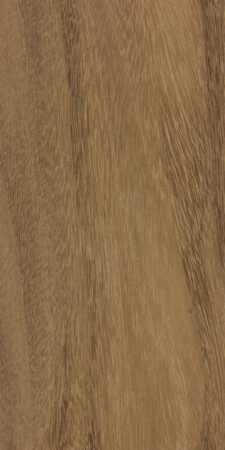
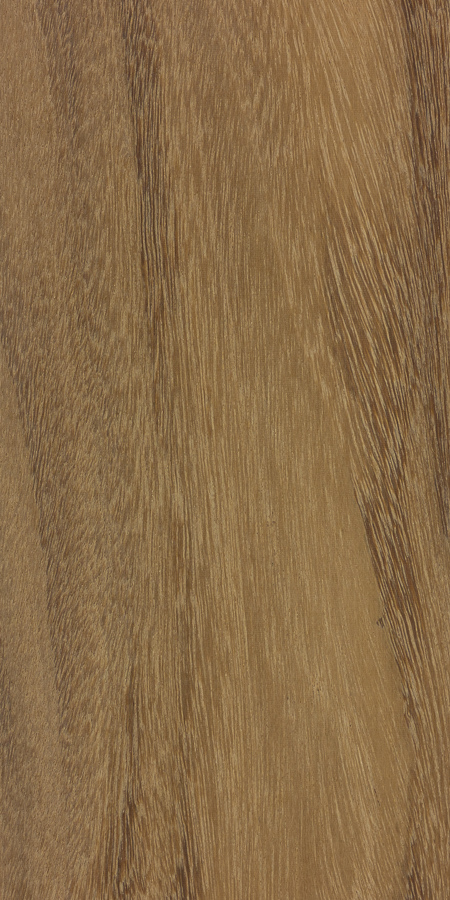
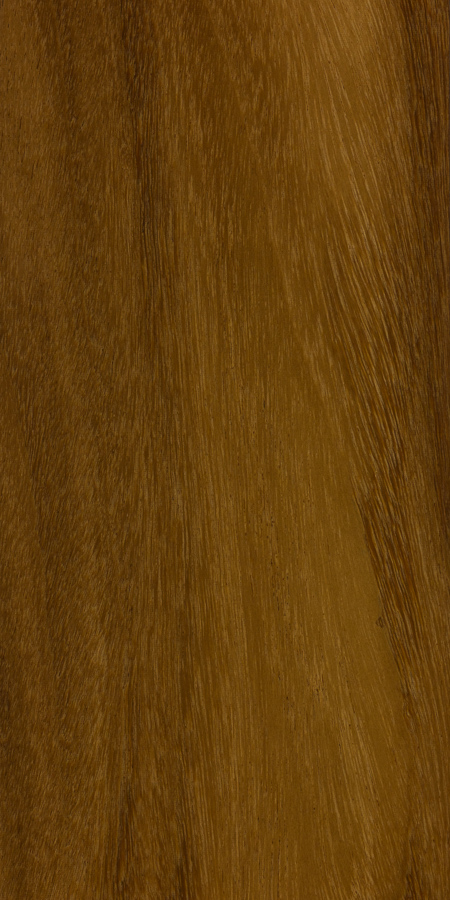
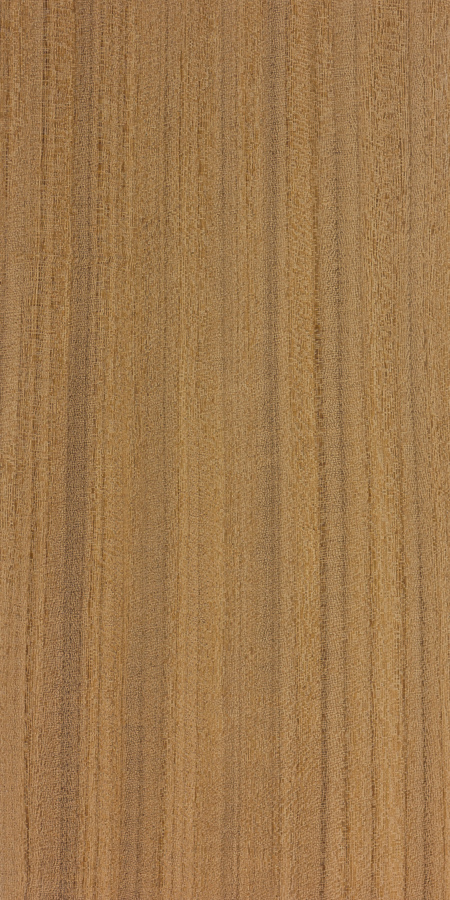
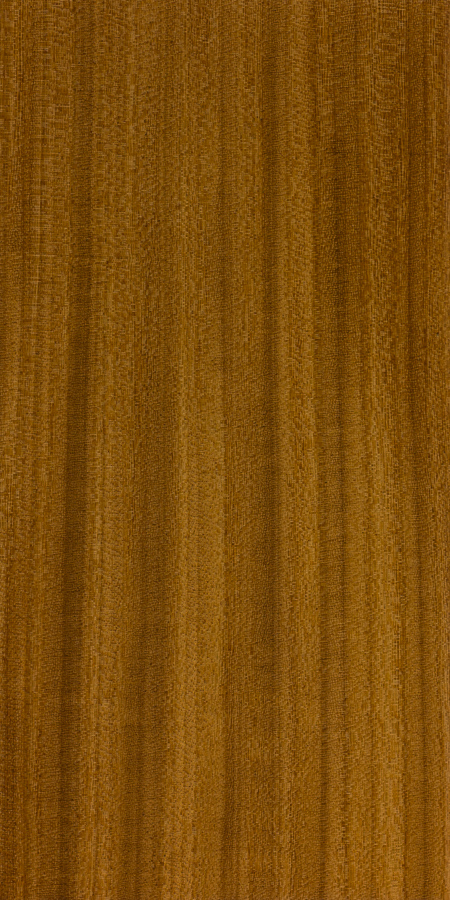
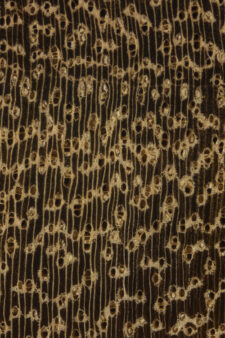

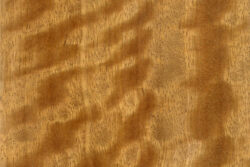
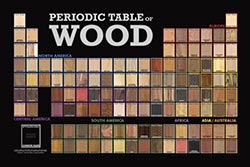
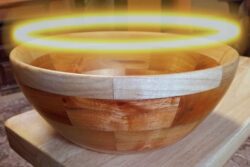
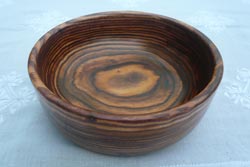





I made a gun stock out of Afromosia. Great to machine. The gun was a German 9mm Mauser
I’ve seen central nervous system effects on other woods also. Just curious what does that entail for people?
Can cutting boards use Afrormosia?
I think I have just turned an Afrormosia bowl from a short sleeper sized chunk I found sitting outside. It looks just like the photos here. The smell though! It reeks of foot! I had to strip off in the workshop before I went in the house. Is this common to this timber?
Most likely it was Dahoma. Commonly used as railway sleepers, in the past and stinks of rotten eggs when freshly cut.
Thanks Andy, I don’t see Dahoma in the database here. Is there another name? Also it’s more a ‘footy’ smell. No trace of the sulphuric egg smell.
Dahoma is the most common name used, but I simply haven’t added it to the site yet.
Dabema is another word
AFRORMOSIA is a CITES listed endangered tree species from Africa, whose trade is heavily regulated and mostly illegal. PLEASE do NOT buy Afrormosia. Either you are being cheated or you are contributing to the illegal deforestation of tropical African rainforests. Be a conscious buyer.
I just turned an eight inch bowl using Aformosia yesterday.
1. It’s pretty hard, so i had to sharpen tools about every ten minutes.
2. You don’t get nice long shavings while turning; rather, you get small “chunks” and a lot of dust.
3. The wood polishes very well and easily with sandpaper.
4. It is beautiful when finished = a soft brown with streaks of ivory color.
Hi, I’m in Ireland. I recently bought a heap of timber sold to me as teak but I’m unsure if it is teak or afromorsia. It’s toungue n groove planks 40mm bolted on edge to form 1.5x1m panels. They were brick curing boards from a factory in Nothern Ireland. I have found quite a few very small insect holes in it as I’m cleaning it up but I can’t tell if they are active or not. Ye are smaller than the average woodworm we get here. Each panel weighs approx 50kg. 6m3 was over 5 tonne. I’m not upset if… Read more »
Very hard to tell from the pictures. If you happen to get a closeup endgrain picture of the raw wood, it would be a lot easier to tell the wood apart that way.
This is as good as I could do with the camera phone
I believe I have a table made of Afromosia. My deceased father in law was a principal at an American school in Legos, Nigeria in the late 60s-70s. It is beautifully hand carve Do! Anyone know what it is worth? Thank you
i am curious if Afrormosia will turn the silver gray color when exposed to natural weathering conditions as Teak does?
As far as I know, just about every wood eventually turns gray when exposed to the elements.
I hung quite a few doors made of afromosia in Coventry cathedral in late 60s , early 70s, I’ve got an oilstone box made of Afromosia, lovely timber.
can I make a bow out of afromosia?
What other types of wood do you use for bows?
English longbows were made from yew
Yes you can if your laminating the woods together , I have used Iroko ( another African teak like wood)
I’m building my new home this year 2015. I’m looking for advise that can i use Afrormosia for my doors in indoor and outdoor. I want to know should it behave good of shrinkage and termite resistant?
Looking for your advise..
Regards
Around 1964/65 I was an apprentice Carpenter and Joiner working in a woodworking machine shop and was involved with the manufacture of large (approx 4m square) multi sectioned window frames designed for a Hospital complex, – and all made from Afrormosia. Being the 1960’s PPE was unheard of and dust masks or respiratory equipment just weren’t issued! I experienced a reaction to working with this wood after a while and this manifested itself in the form of my body becoming covered in very itchy blotches and with any splinters or ‘skelfs’ which penetrated the skin, (No gloves in those days… Read more »
I started my carpenter and joiner apprenticeship in 1962. We used aformosa but I did not get any reaction from it or from any other timber.
I agree, not any health and safety in those days except, for what is sadly lacking these days, common sense and the wrath of the foreman if he did not approve of what you were doing,
James
Pls have u heard about the name ‘ebelebe’. Its d name they call a particular wood in Kogi state. Can someone help me with other names they call it. Thanks
I can’t comment on *where* each of these common names are from, but I found these names in use to represent Afrormosia:
Anyeran, Asamela, Assamela, Assemela, Awawai, Ayin, Baracara, Bohala, Bohalala, Bonsamdua, Devils tree, Egbi, Ejen, Jatobahy do igapo, Kokriki, Kokrodua, Mekoe, Mohole, Obang, Ole, Olel Pardo, Peonio, Tento, Wahala
I have a djembe drum from Guinea made of Pericopsis laxiflora, otherwise known as afromosia or, as the drum maker called it, Kolo Kolo. It is considered quite a rare and special wood for drums and I’ve only seen three out of this wood out of many hundreds. It is a wonderful drum wood. I haven’t carved or sanded it, so have no info about problems, but many hardwoods are toxic on the skin or in the lungs. One of the worst is cocobolo, a rosewood. Don’t take chances breathing any hardwood dust. When it mixes with mucous inside the… Read more »
I want to know if the local name for afromosia is Ayin in d western part of Nigeria
Hello Lawal. I hope you were able to get answer to this question? Please, I want to know what afromosiabis called in Yoruba and hausa. Help me out
Be very careful when working with this wood. Particularly sanding. Wear a mask. I first hand experienced why you should do this. You do not! This will affect people differently however it is not pleasant whatsoever if you end up being as sensitive to its toxicity as I was. Overall you will be OK as long as you wear respiratory protection and work with it OUTSIDE no matter how small a project.
Am work on afrormosia elata i need information on d silvicultural treatment
I’m working on Afrormosia as my project right.pls helpme out with informations.
I wanna use Afromosia elata as project